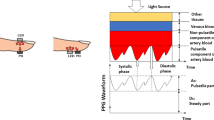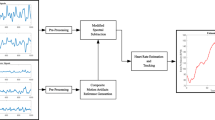Abstract
In order to realize high-accuracy heart rate (HR) estimation based on photoplethysmography (PPG) under the scenes of low signal-to-noise ratio (SNR) and co-frequency caused by motion artifacts (MAs), this paper presents a novel framework integrating two-stage variational mode decomposition (VMD) denoising method, noise compensation technology, and hidden Markov model (HMM)-based tracking algorithm. The two-stage VMD denoising method is designed to separate the HR signal from MA under low SNR scene. The noise compensation technology is applied to solve the problem of co-frequency. HMM-based HR tracking method is adopted to obtain the global optimization performance of HR estimation. The effectiveness and superiority of the proposed framework in solving problems of low SNR and co-frequency associated with motion artifacts have been verified by the HR estimation experiments carried out on three public high-SNR PPG databases (ISPC, BAMI I, BAMI II) and a self-built low-SNR database (WeData). Compared with the two classical frameworks namely joint sparse spectrum reconstruction (JOSS) and convolutional neural network-long short-term memory network (CNN-LSTM), the proposed framework obtains the lowest HR estimation errors (0.94 beats per minute (BPM) and 1.81 BPM respectively) on both BAMI 2 with the highest SNR (0.40 dB) and WeData with the lowest SNR (− 9.07 dB). For the low-SNR database Wedata, the average absolute error (AAE) decreases by more than 21 BPM. The research result of this study provides a solution for the realization of high-accuracy PPG-based HR estimation in exercise scenarios.
Graphical abstract









Similar content being viewed by others
References
Challoner AVJ, Ramsay CA (1974) A photoelectric plethysmograph for the measurement of cutaneous blood flow. Phys Med Biol 19(3):317–328
Tamura T et al (2014) Wearable photoplethysmographic sensors—past and present. Electronics 3(2):282–302
Lu Z, Yi T, Hong Z (2021) A review of PPG/NIRS acquisition ASIC and system. 2021 IEEE 14th International Conference on ASIC (ASICON). IEEE 2021:1–4
Biswas D, Simues-Capela N, Hoof CV et al (2019) Heart rate estimation from wrist-worn photoplethysmography: a review. IEEE Sensors Journal 1–1
Ugnell H, Lindberg LG, Oberg PA (1991) Monitoring of heart-and respiration rates using a fiber optic sensor[C]//Proceedings of the Annual International Conference of the IEEE Engineering in Medicine and Biology Society Volume 13. IEEE 1991:1566–1567
Luke A, Shaji S, Unnikrishna Menon KA (2018) Motion artifact removal and feature extraction from PPG signals using efficient signal processing algorithms. 2018 International Conference on Advances in Computing, Communications and Informatics (ICACCI). IEEE 2018:624–630
Kumar A, Komaragiri R, Kumar M (2022) Reference signal less Fourier analysis based motion artifact removal algorithm for wearable photoplethysmography devices to estimate heart rate during physical exercises. Comput Biol Med 141:105081
He W et al (2018) Variational mode decomposition-based heart rate estimation using wrist-type photoplethysmography during physical exercise. 2018 24th International Conference on Pattern Recognition (ICPR). IEEE 2018:3766–3771
Han H, Kim J (2012) Artifacts in wearable photoplethysmographs during daily life motions and their reduction with least mean square based active noise cancellation method. Comput in Biol Med 42(4):387–393
Arunkumar KR, Srivathsa R, Bhaskar M (2018) Improved heart rate estimation from photoplethysmography during physical exercise using combination of NLMS and RLS adaptive filters. TENCON 2018-IEEE Region 10 Conference. IEEE 2018:0420–0424
Arunkumar KR, Bhaskar M (2020) Robust de-noising technique for accurate heart rate estimation using wrist-type ppg signals. IEEE Sensors J 20(14):7980–7987
Zhu L, et al (2018) Heart rate monitoring during physical exercise from photoplethysmography using neural network. IEEE Sensors Lett 3(1):1–4
Chung H et al (2019) Deep learning for heart rate estimation from reflectance photoplethysmography with acceleration power spectrum and acceleration intensity. IEEE Access 99(2020):1–1
Zhang Z, Pi Z, Liu B (2015) TROIKA: a general framework for heart rate monitoring using wrist-type photoplethysmographic signals during intensive physical exercise. IEEE Trans Biomed Eng. 62(2):522–531
Lakshminarasimha Navannet K, M, et al (2015) Multiple spectral peak tracking for heart rate monitoring from photoplethysmography signal during intensive physical exercise. IEEE Signal Proces Lett 22(12):2391–2395
Zhang Z (2015) Photoplethysmography-based heart rate monitoring in physical activities via joint sparse spectrum reconstruction. IEEE Trans Biomed Eng 62(8):1902
Fujita Y, Hiromoto M, Sato T (2018) PARHELIA: particle filter-based heart rate estimation from photoplethysmographic signals during physical exercise. IEEE Trans Biomed Eng 67(1):189–198
Hotelling H (1936) Relations between two sets of variates. Biometrika 28:321–377
Hardoon DR, Szedmak S, Shawe-Taylor J (2004) Canonical correlation analysis: an overview with application to learning methods. Neural Comput 16(12):2639–2664
Dragomiretskiy K, Zosso D (2014) Variational mode decomposition. IEEE Trans Signal Process 62(3):531–544
Bertsekas DP (1976) Multiplier methods: a survey Automatica 12(2):133–145
Wright S, Nocedal J (1999) Numerical optimization. Springer Science 35(67–68):7
Hestenes MR (1969) Multiplier and gradient methods. J Optim Theory Appl 4(5):303–320
Rockafellar RT (1973) A dual approach to solving nonlinear programmingproblems by unconstrained optimization. Math Program 5(1):354–373
Bertsekas DP (2014) Constrained optimization and Lagrange multiplier methods. Academic press
Baum LE, Petrie T (1966) Statistical inference for probabilistic functions of finite state Markov chains. Ann Math Stat 37(6):1554–1563
Baum LE, Eagon JA (1967) An inequality with applications to statistical estimation for probabilistic functions of Markov processes and to a model for ecology. Bull Amer Math Stat 73(3):360–363
Baum LE (1968) Growth functions for trasformations on manifolds. Pac J Math 27
Baum LE et al (1970) A maximization technique occurring in the statistical analysis of probabilistic functions of Markov chains. Ann Math Stat 41(1):164–171
Baum LE (1972) An inequality and associated maximization technique in statistical estimation for probabilistic functions of Markov processes. Inequalities 3(1):1–8
Rabiner LR (1989) A tutorial on hidden Markov models and selected applications in speech recognition. Proceedings of the IEEE 77(2):257–286
Funding
This work was supported by the National Nature Science Foundation of China under Grants 61871360 and 61671417.
Author information
Authors and Affiliations
Corresponding author
Ethics declarations
Ethics approval
This work involved human subjects or animals in its research. Approval of all ethical and experimental procedures and protocols was granted by Ethics Review Committee of First Affiliated Hospital of Anhui Medical University, Hefei, Anhui, China, under Application No. PJ 2014–08-04.
Additional information
Publisher's note
Springer Nature remains neutral with regard to jurisdictional claims in published maps and institutional affiliations.
Rights and permissions
Springer Nature or its licensor holds exclusive rights to this article under a publishing agreement with the author(s) or other rightsholder(s); author self-archiving of the accepted manuscript version of this article is solely governed by the terms of such publishing agreement and applicable law.
About this article
Cite this article
Zhao, J., Chen, X., Zhang, X. et al. A solution for co-frequency and low SNR problems in heart rate estimation based on photoplethysmography signals. Med Biol Eng Comput 60, 3419–3433 (2022). https://doi.org/10.1007/s11517-022-02678-x
Received:
Accepted:
Published:
Issue Date:
DOI: https://doi.org/10.1007/s11517-022-02678-x




